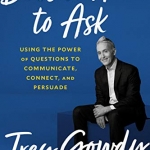Blogging Lessons From the Courtroom

‘The courtroom was his job, writes Trey Goudy in Doesn’t Hurt to Ask, but you, too, he tells readers, will need to successfully advocate about something or someone. You will be persuading others to either come closer to your way of thinking or at least see why it is you believe what you believe, he says.
Based on Goudy’s decades-long experience as a prosecutor, he has arrived at certain conclusions about what persuasion is not (debating or arguing) and what it is (incremental). Both conclusions relate directly to blog marketing, I couldn’t help thinking. Blogging is certainly incremental, delivering information on a topic over a series of different posts, all part of a longer, ongoing, messaging process.
You have your facts, Goudy says, as you’re preparing to persuade, with a sense of which are most compelling. You’ve prioritized them properly. You’ve thought through every point and have a plan for defending it. But only sometimes, he admits, is the objective knowable (such as a verdict or an election tally). In real life, persuasion is movement, and movement can be small at times. In fact, I mused, in blog content marketing, persuasion is meant to happen in small increments.
Think how they think, Goudy advises (he might well have been referring to blog readers as much as to a jury). What do you really know about what they think? he asks. You’ve spent time gathering all the relevant facts, but you need to have a clear sense of which group you are trying to move, persuade, or convince. .Then comes evaluating how heavy a “lift” you need. Remember, if you are resolute in your own mind, chances are good that the audience is resolute in theirs, he reminds us.
In a non-digital conversation, you can come across as agreeable and likeable by saying things such as “I understand where you are coming from.” In blog marketing, however, the printed words are your one tool to demonstrate that level of likability and openness. “Start with your consensual point,” the author advises, “not your most provocative one.”
In the arena of persuasion, traits to be desired include believability, likability, authenticity – and access to facts. In a courtroom, Goudy says, you want to “impeach” the statements made by the other side (the facts they rely on and the overarching principles or conclusion behind those facts, but not the people).
Since blog content writers’ tools are words, Goudy’s chapter on “Big Words, Soft Words” offers helpful concepts. Certain words, he says, are “simply too big to make for objective and precise communications”. One of those words is “always” (as in “You always interrupt me when I am speaking”). Virtual or no, discussions need to allow for respectful dialogue.
The final paragraph of the book might have been directed specifically towards blog content writers: “Go communicate what you believe and why you believe it in the most persuasive way possible.”






Follow us online!